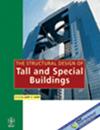轴压作用下不锈钢圆钢管混凝土短柱的尺寸效应
IF 1.3
3区 工程技术
Q3 CONSTRUCTION & BUILDING TECHNOLOGY
引用次数: 1
摘要
钢管混凝土(CFSST)构件结合了不锈钢材料和钢管混凝土(CFST)构件的优点。因此,在海洋环境和其他需要高耐久性和耐腐蚀性的场景中,它比CFST构件具有更广泛的应用范围。然而,对大型CFSST构件的研究却非常有限。本文以30根不同钢比(3.7%≤α≤10.3%)、直径(500 mm≤D≤900 mm)、混凝土强度(fcu = 40 MPa、50 MPa)的圆形CFSST构件为研究对象,研究了轴压作用下的尺寸效应。对于峰值轴向应力、峰值轴向应变和复合材料弹性模量,研究了尺寸效应。结果表明,构件的峰值轴向应力和峰值轴向应变随直径的增大而增大。随着直径的增大,复合材料弹性模量基本保持不变,说明尺寸对复合材料弹性模量没有明显的影响。轴向峰值应力和轴向峰值应变的尺寸效应受钢比的影响。增大钢比有减小尺寸效应的趋势。根据生成的数据,发现中国和欧洲现行规范明显低估了CFSST短柱的极限承载力。基于GB 50936‐2014和EN 1994‐1‐1设计规范,本文提出的设计模型对低钢比的大型奥氏体CFSST柱抗力进行了修正,能够较好地预测其抗力。本文章由计算机程序翻译,如有差异,请以英文原文为准。
Size effect of circular concrete‐filled stainless steel tubular short columns under axial compression
Concrete‐filled stainless steel tube (CFSST) members combine the advantages of stainless steel materials and concrete‐filled steel tube (CFST) members. Therefore, it has a broad range of applications than CFST members in the marine environment and other scenarios requiring great durability and corrosion resistance. However, there are limited researches on the large‐sized CFSST members. In this paper, 30 circular CFSST members with varying steel ratios (3.7% ≤ α ≤ 10.3%), diameters (500 mm ≤ D ≤ 900 mm), and strength of concrete ( fcu = 40 MPa, 50 MPa) are studied on the size effect under axial compression. For peak axial stress, peak axial strain, and composite elastic modulus, size effects are investigated. According to the results, the peak axial stress and peak axial strain of the members increase with the increase in diameter. The modulus of composite elasticity essentially stays constant as the diameter increases, showing that there is no obvious size effect on the composite elastic modulus. The size effect of peak axial stress and peak axial strain is influenced by the steel ratio. Increasing the steel ratio tended to decrease the size effect. According to the generated data, it was found that the current codes of Chinese and European underestimate the ultimate bearing capacity of CFSST short columns significantly. To this end, the resistances of the large‐sized austenitic CFSST columns with a low steel ratio are well predicted by the proposed design model after being modified, based on GB 50936‐2014 and EN 1994‐1‐1 design codes.
求助全文
通过发布文献求助,成功后即可免费获取论文全文。
去求助
来源期刊
CiteScore
5.30
自引率
4.20%
发文量
83
审稿时长
6-12 weeks
期刊介绍:
The Structural Design of Tall and Special Buildings provides structural engineers and contractors with a detailed written presentation of innovative structural engineering and construction practices for tall and special buildings. It also presents applied research on new materials or analysis methods that can directly benefit structural engineers involved in the design of tall and special buildings. The editor''s policy is to maintain a reasonable balance between papers from design engineers and from research workers so that the Journal will be useful to both groups. The problems in this field and their solutions are international in character and require a knowledge of several traditional disciplines and the Journal will reflect this.
The main subject of the Journal is the structural design and construction of tall and special buildings. The basic definition of a tall building, in the context of the Journal audience, is a structure that is equal to or greater than 50 meters (165 feet) in height, or 14 stories or greater. A special building is one with unique architectural or structural characteristics.
However, manuscripts dealing with chimneys, water towers, silos, cooling towers, and pools will generally not be considered for review. The journal will present papers on new innovative structural systems, materials and methods of analysis.

 求助内容:
求助内容: 应助结果提醒方式:
应助结果提醒方式:


